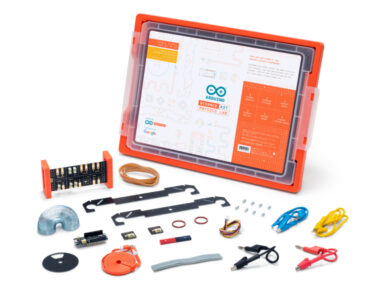
Overview
The MKR Proto Large Shield fits onto your MKR board using its provided female/male headers and enables you to fix it wherever you want with the mounting holes. This shield features a larger prototyping area with more than 300 solder points and makes connecting components to your board super simple, thanks to the silk that indicates the MKR board pins location
Tech specs
| Digital I/O Pins | 21 |
| PWM Digital I/O Pins | depending on the board |
| Analog Input Pins | 7 |
| Analog Output Pins | depending on the board |
| DC Current per I/O Pin | depending on the board |
| DC Current for 3.3V Pin | depending on the board |
| DC Current for 5V Pin | depending on the board |
| Lenght | 80 mm |
| Width | 50 mm |
| Weight | 19 gr |
Conformities
Resources for Safety and Products
Manufacturer Information
The production information includes the address and related details of the product manufacturer.
Arduino S.r.l.
Via Andrea Appiani, 25
Monza, MB, IT, 20900
https://www.arduino.cc/
Responsible Person in the EU
An EU-based economic operator who ensures the product's compliance with the required regulations.
Arduino S.r.l.
Via Andrea Appiani, 25
Monza, MB, IT, 20900
Phone: +39 0113157477
Email: support@arduino.cc
Documentation
OSH: Schematics
The MKR Large Proto Shield is open-source hardware! You can build your own board using the following files:
EAGLE FILES IN .ZIP SCHEMATICS IN .PDFGet Inspired

Launched back in January 2019 in partnership with Google, the Arduino Science Kit Physics Lab is designed for middle school students (aged 11 to 14) to explore science. It is now available with Italian and Spanish course content, making it more accessible than ever. “You discovered it yourself, so it was really fun doing that.” - UK student from ARK Burlington Danes Academy The Arduino Science Kit Physics Lab requires no prior electronics knowledge. It features online course content and equipment to conduct and test the fundamental laws of traditional physics through nine exciting science projects inspired by popular fairground rides like the Gravitron and Pirate Ship. It is perfect for developing transferable skills such as critical thinking and problem solving through an inquiry-based learning approach. Students will experiment with forces, motion, magnetism, and conductivity — making their own hypothesis like real scientists, checking their assumptions, and logging data in real-time using Google’s Science Journal for Android. “Makes it more accessible for students to do practical physics.” - Graeme Wood, Physics teacher at ARK Burlington Danes Academy Incredibly easy to get started, students simply connect their Android mobile device to the board, build their project, and then use the onboard sensor and plug-and-play modules to simulate the rides’ dynamics. Data is transmitted from the experiment to the student's mobile device via Bluetooth, where they can analyse and record their results in Google’s Science Journal App or worksheets. The Arduino Education Science Kit Physics Lab isn't confined to the classroom. In fact, students can use the kit outdoors to turn the playground into their very own fairground by applying the concepts they've learned to design and test their own rides. Based upon the Arduino MKR WiFi 1010, it is a fully portable lab including a range of sensors to measure light, temperature, motion, and








